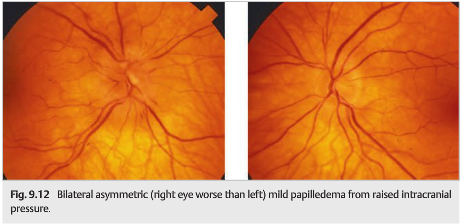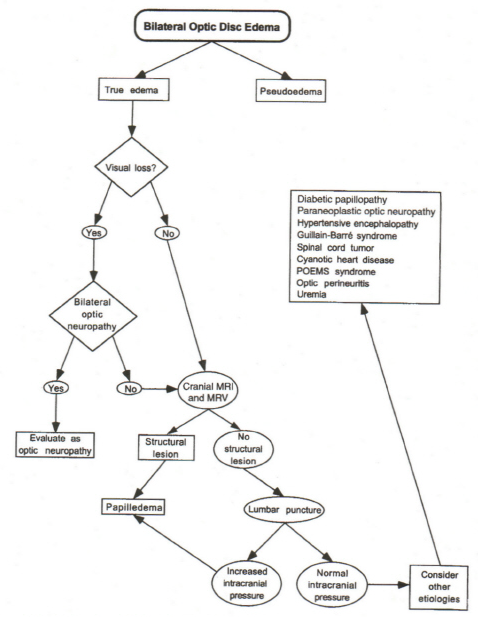Question: Describe the appropriate steps to take in the emergency department when evaluating bilaterally swollen discs.
 3
3
_________________________________________
ED concerns: malignant hypertension, intracranial mass, hemorrhage, infection, brain edema, idiopathic intracranial hypertension, bilateral optic neuropathy
Papilledema is the term reserved for disc swelling due to increased intracranial pressure. The absence of disc swelling or the presence of spontaneous venous pulsations does not rule-out increased intracranial pressure.
ED evaluation of bilateral optic disc swelling
1. Check blood pressure to rule-out malignant hypertension
2. Urgently determine presence of pseudo-disc edema is present
A. Small crowded optic nerve head, disc drusen, congenital anomaly
B. Ocular ultrasound if suspicious of disc drusen
3. True disc edema
A. Obtain emergent neurology consultation
B. Obtain emergent brain MRI with contrast
a. Normal imaging, venous thrombosis or meningeal enhancement
– Obtain lumbar puncture with opening pressure and CSF analysis (cell count & differential, glucose, protein, cytology, VDRL, appropriate studies for microbial agents)
➧ Normal – suspect pseudo disc edema
➧ Elevated or abnormal CFS contents
⏩ Obtain Brain/Neck MRV = venous stasis thrombosis, chronic meningitis, spinal cord tumor, idiopathic intracranial hypertension
⧫ Abnormal – obtain appropriate emergent consultations
b. Abnormal – obtain appropriate emergent consultations
 3
3
The Clinical Validity of the Spontaneous Retinal Venous Pulsation. Wong and White: J Neuro-Ophthalmol 2012
Traditional teaching is that the presence of spontaneous venous pulsations tends to rule-out increased intracranial pressure, and that their absence does not mean it is present. However, a 2012 publication found that “Thirteen of 106 (12.3%) patients had high opening (greater than or equal to 30 cmH2O), and spontaneous venous pulsation was present in 11 of 13 patients (86%) with high opening pressure.”
Bilateral Optic Disc Swelling Care Path
From: Clinical Pathways in Neuro-ophthalmology 2003

References:
1. Clinical Decisions in Neuro-Ophthalmology, Burde RM, Savino PJ & Trobe JD. 3nd Edition. Mosby 2002
2. Clinical Pathways in Neuro-ophthalmology:An Evidence-Based Approach. Lee AC & Brazis PW. Thieme 2003
3. Neuro-ophthalmology Illustrated. Biousse V, Newman NJ. 2nd Edition. Thieme. 2016
More than 600 additional neuro-ophthalmology questions are freely available at http://EyeQuiz.com.
Questions prior to September 2016 are archived at http://ophthalmology.stanford.edu/blog/
After that, questions are archived at https://neuro-ophthalmology.stanford.edu
Follow https://twitter.com/NeuroOphthQandA to be notified of new neuro-ophthalmology questions of the week.
Please send feedback, questions and corrections to tcooper@stanford.edu.